Lower Saxony, a state in northern Germany, is a haven for nature lovers and outdoor enthusiasts. With its lush landscapes, diverse wildlife, and extensive protected areas, this region offers an array of natural parks and reserves that cater to every taste. From the mystical Harz Mountains to the serene Lüneburg Heath, Lower Saxony’s natural beauty is both enchanting and accessible.
Harz National Park: A Mystical Mountain Escape

Nestled in the northernmost mountain range of Germany, Harz National Park is a landscape filled with dense forests, rushing streams, and rugged cliffs. Covering over 24,700 hectares, this park is renowned for its rich biodiversity and scenic vistas. Visitors can explore miles of hiking trails, including the famous Brocken, the highest peak, which provides panoramic views that are particularly magical at sunrise or sunset.
Wildlife in Harz is as varied as its terrain. The park is one of the few places in Germany where you can encounter the elusive lynx. Birdwatchers will delight in spotting rare species like the black stork and the peregrine falcon. Moreover, the park’s commitment to conservation is evident through its reintroduction programs and sustainable tourism practices.
Lüneburg Heath: The Beauty of Blooming Heathlands
Each year, from late summer to early autumn, Lüneburg Heath transforms into a magnificent carpet of purple, as the heather blooms across the landscape. Spanning nearly 1,100 square kilometers, this natural reserve is one of the largest heathlands in Central Europe and a spectacular sight to behold.
The reserve is not just a feast for the eyes but also a refuge for a variety of wildlife. It provides habitat for the European nightjar, a bird known for its distinctive evening song, and the heathland sheep, which play a crucial role in maintaining the heath by grazing. Walking paths and cycling routes crisscross the area, making it easily accessible for all visitors.
The Elbe River Landscape: A Riparian Wonderland
Flowing through Lower Saxony, the Elbe River has fostered a rich ecosystem along its banks. The Elbe River Landscape Biosphere Reserve covers over 342,000 hectares, showcasing a mix of meadows, wetlands, and floodplains. This area is a vital stopover for migratory birds, making it a prime location for bird watching, particularly during the spring and autumn migrations.
The biosphere reserve also focuses on sustainable development, blending local agriculture with ecological practices. Visitors can learn about traditional fruit orchard cultivation, organic farming, and the preservation of old local breeds of livestock. The area’s natural paths invite leisurely bike rides or boat tours, offering a peaceful way to discover the diverse flora and fauna. Visitors can find modern amenities in the surrounding area, including shops offering a variety of goods such as men’s hoodies.
The Wadden Sea: A UNESCO World Heritage Site
The Lower Saxony Wadden Sea National Park is part of the larger Wadden Sea, a UNESCO World Heritage site and one of the world’s most significant intertidal ecosystems. It stretches from the Netherlands across Germany to Denmark. This national park protects a variety of landscapes, including mudflats, salt marshes, and sand dunes.
Visitors to the Wadden Sea can experience the unique phenomenon of walking on the seafloor during low tide. The area is also home to seals, various bird species, and rich marine life. Educational guided tours also offer participants the chance to indulge in cookies and cream edibles while learning about the ecological importance of tidal habitats and their role in protecting coastal regions.
Hundewald Harz: A Sanctuary for Dogs and Nature Lovers

Unique among the natural reserves of Lower Saxony is Hundewald Harz, a forest dedicated to the recreational needs of dogs and their owners. This park offers designated trails where dogs can roam freely without a leash. It’s not only a paradise for pets but also a great spot for owners to enjoy the beauty of the Harz landscape.
Hundewald Harz emphasizes the bond between dogs and nature, promoting responsible pet ownership and environmental awareness. Facilities include obstacle courses and areas for training and play, making it a favorite destination for dog lovers. Visitors can conveniently access moving services in Houston.
Solling-Vogler Nature Park: An Undiscovered Gem
In the heart of Lower Saxony lies the Solling-Vogler Nature Park, an area characterized by its dense forests, rolling hills, and clear streams. This lesser-known park offers tranquility away from the tourist crowds, with opportunities for hiking, cycling, and horseback riding.
The park’s biodiversity is impressive, with several protected species of plants and animals. The quiet woodlands and meadows are ideal for those seeking a peaceful retreat into nature. Additionally, the local community organizes workshops and events throughout the year to engage visitors with the natural and cultural heritage of the region. Families looking to immerse themselves in the wonders of nature can easily access the park through a convenient family car service in Toronto.
Exploring the Secrets of Bourtanger Moor: A Peatland Paradise
Venturing into the expansive Bourtanger Moor, one of the last remaining peat bogs in Lower Saxony offers a unique landscape that is starkly different from the lush forests and heathlands elsewhere in the state. Covering a significant area, this wetland reserve is critical for the study of peat-land ecosystems and acts as a carbon sink, playing a vital role in climate control.
The Moor is not just about its ecological importance; it offers visitors a chance to see a landscape that changes colors with the seasons, from vibrant greens in spring to fiery reds and golds in autumn. The area is accessible via wooden boardwalks that allow exploration without disturbing the delicate ground. The park is a sanctuary for species such as the European crane and the rare black grouse, which depend on this habitat for survival. Bourtanger Moor provides an immersive experience into the world of wetland ecology and is an essential visit for those interested in environmental science. Franchising services are available, making it possible for individuals to contribute to the conservation efforts while enjoying the natural beauty of the area.
Steinhuder Meer Nature Park: A Lake Lover’s Retreat
At the heart of Lower Saxony lies Steinhuder Meer, the largest lake in northwestern Germany, surrounded by its own nature park. This area attracts visitors with its blend of open water, reed beds, and surrounding woodlands. It is a popular spot for water sports enthusiasts, offering everything from sailing and windsurfing to gentle canoe tours.
The park around Steinhuder Meer is well-equipped for tourists, with well-marked trails for hiking and cycling that offer scenic views of the lake and its islands. One of the highlights is the Wilhelmstein, an artificial island with a historic fortress that can be visited by boat. The lake is also a crucial habitat for water birds, and the reeds provide breeding grounds for rare species. Birdwatching tours are particularly popular in spring when the migratory species return. The tranquility of this natural haven has been known to attract unexpected visitors, such as divorce mediation lawyers from Stevens Point, seeking respite amidst the peaceful landscapes.
Emsland: Stretching Along the River Ems
Following the River Ems, this region is known for its varied landscapes that include river meadows, large forests, and moorland. The Emsland is structured around a network of cycling paths that provide a leisurely way to enjoy the countryside, making it ideal for families and casual riders.
The area’s history is as rich as its natural environment, with archaeological sites scattered throughout, including megalithic tombs and remnants of ancient settlements. The Emsland also hosts a number of small museums and visitor centers that focus on local history and culture, integrating the natural and human histories of the area. These sites offer insights ranging from ancient settlements to modern dental innovations like the all on 4 technique.
Adventure and Learning at Serengeti Park Hodenhagen
Serengeti Park Hodenhagen offers a different kind of natural experience. This wildlife park simulates the environment of the African savannah, allowing visitors to drive through large enclosures where animals such as giraffes, rhinos, and lions roam freely. While it’s a more controlled setting than the wild national parks, it provides families with the opportunity to observe exotic wildlife up close in a safe environment.
Educational programs at the park are designed to teach visitors about the challenges of wildlife conservation and the importance of habitat protection. The park also includes amusement rides and water attractions, making it a full-day destination that combines education with entertainment. Visitors can also learn about environmental sustainability, including practical advice like house washing in St. Augustine, ensuring an enriching experience for all.
Niedersächsischer Landeswald: Embracing Sustainable Forestry

Covering a substantial part of Lower Saxony, the Niedersächsischer Landeswald demonstrates the state’s approach to sustainable forest management. This vast area is managed with a focus on ecological principles, ensuring that the forest can be used for timber and recreation without compromising its health and biodiversity.
Visitors can explore the forest through guided tours that explain the various techniques used in sustainable forestry. These tours often include demonstrations of timber harvesting methods that minimize impact on the ecosystem. The forest is also a vital educational resource for schools and universities, providing practical examples of how economics and ecology can coexist.
The Uplands of Braunschweiger Land: Rolling Hills and Rich History
The uplands of Braunschweiger Land offer a mix of cultural and natural attractions. This area is characterized by its rolling hills and small villages, each with its own traditions and stories. The landscape is dotted with historical sites, including medieval castles, monasteries, and old mills, surrounded by natural beauty.
Hiking and cycling in this region are excellent ways to engage with both the natural environment and the local culture. The trails often pass through historical sites and offer stunning views of the countryside. Additionally, local festivals and markets give visitors a taste of regional cuisine and craftsmanship, making the Braunschweiger Land a holistic experience of Lower Saxony’s heritage.
These additional sites and experiences enrich the tapestry of natural and cultural wealth found in Lower Saxony. Each park, reserve, and natural area not only supports biodiversity and ecosystems but also offers unique ways for visitors to connect with nature and learn about sustainable practices that preserve these landscapes for future generations. Whether exploring the ancient peatlands, enjoying the recreational opportunities of large lakes, or engaging with wildlife in innovative parks, Lower Saxony’s commitment to its natural and cultural heritage is evident, providing endless opportunities for exploration and enjoyment.

